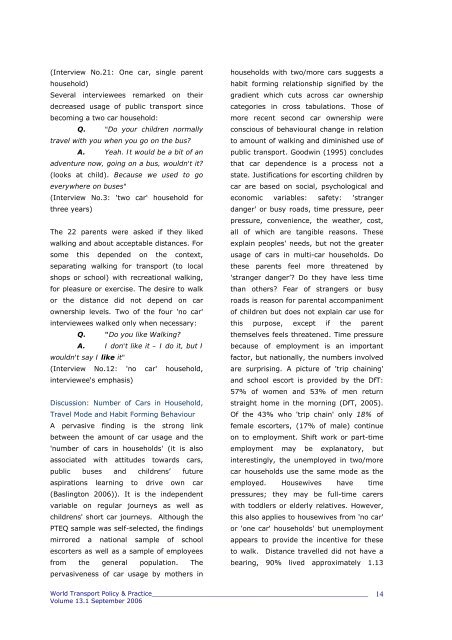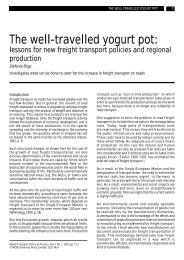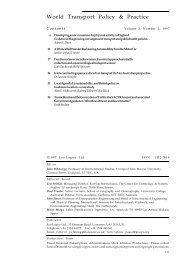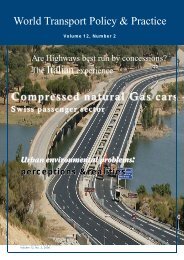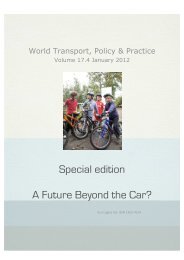Effects of pedestrianisation on the commercial and ... - Eco-Logica
Effects of pedestrianisation on the commercial and ... - Eco-Logica
Effects of pedestrianisation on the commercial and ... - Eco-Logica
You also want an ePaper? Increase the reach of your titles
YUMPU automatically turns print PDFs into web optimized ePapers that Google loves.
(Interview No.21: One car, single parent<br />
household)<br />
Several interviewees remarked <strong>on</strong> <strong>the</strong>ir<br />
decreased usage <str<strong>on</strong>g>of</str<strong>on</strong>g> public transport since<br />
becoming a two car household:<br />
Q. "Do your children normally<br />
travel with you when you go <strong>on</strong> <strong>the</strong> bus?<br />
A. Yeah. It would be a bit <str<strong>on</strong>g>of</str<strong>on</strong>g> an<br />
adventure now, going <strong>on</strong> a bus, wouldn't it?<br />
(looks at child). Because we used to go<br />
everywhere <strong>on</strong> buses"<br />
(Interview No.3: 'two car' household for<br />
three years)<br />
The 22 parents were asked if <strong>the</strong>y liked<br />
walking <strong>and</strong> about acceptable distances. For<br />
some this depended <strong>on</strong> <strong>the</strong> c<strong>on</strong>text,<br />
separating walking for transport (to local<br />
shops or school) with recreati<strong>on</strong>al walking,<br />
for pleasure or exercise. The desire to walk<br />
or <strong>the</strong> distance did not depend <strong>on</strong> car<br />
ownership levels. Two <str<strong>on</strong>g>of</str<strong>on</strong>g> <strong>the</strong> four 'no car'<br />
interviewees walked <strong>on</strong>ly when necessary:<br />
Q. "Do you like Walking?<br />
A. I d<strong>on</strong>'t like it – I do it, but I<br />
wouldn't say I like it"<br />
(Interview No.12: 'no car' household,<br />
interviewee's emphasis)<br />
Discussi<strong>on</strong>: Number <str<strong>on</strong>g>of</str<strong>on</strong>g> Cars in Household,<br />
Travel Mode <strong>and</strong> Habit Forming Behaviour<br />
A pervasive finding is <strong>the</strong> str<strong>on</strong>g link<br />
between <strong>the</strong> amount <str<strong>on</strong>g>of</str<strong>on</strong>g> car usage <strong>and</strong> <strong>the</strong><br />
'number <str<strong>on</strong>g>of</str<strong>on</strong>g> cars in households' (it is also<br />
associated with attitudes towards cars,<br />
public buses <strong>and</strong> childrens’ future<br />
aspirati<strong>on</strong>s learning to drive own car<br />
(Baslingt<strong>on</strong> 2006)). It is <strong>the</strong> independent<br />
variable <strong>on</strong> regular journeys as well as<br />
childrens' short car journeys. Although <strong>the</strong><br />
PTEQ sample was self-selected, <strong>the</strong> findings<br />
mirrored a nati<strong>on</strong>al sample <str<strong>on</strong>g>of</str<strong>on</strong>g> school<br />
escorters as well as a sample <str<strong>on</strong>g>of</str<strong>on</strong>g> employees<br />
from <strong>the</strong> general populati<strong>on</strong>. The<br />
pervasiveness <str<strong>on</strong>g>of</str<strong>on</strong>g> car usage by mo<strong>the</strong>rs in<br />
households with two/more cars suggests a<br />
habit forming relati<strong>on</strong>ship signified by <strong>the</strong><br />
gradient which cuts across car ownership<br />
categories in cross tabulati<strong>on</strong>s. Those <str<strong>on</strong>g>of</str<strong>on</strong>g><br />
more recent sec<strong>on</strong>d car ownership were<br />
c<strong>on</strong>scious <str<strong>on</strong>g>of</str<strong>on</strong>g> behavioural change in relati<strong>on</strong><br />
to amount <str<strong>on</strong>g>of</str<strong>on</strong>g> walking <strong>and</strong> diminished use <str<strong>on</strong>g>of</str<strong>on</strong>g><br />
public transport. Goodwin (1995) c<strong>on</strong>cludes<br />
that car dependence is a process not a<br />
state. Justificati<strong>on</strong>s for escorting children by<br />
car are based <strong>on</strong> social, psychological <strong>and</strong><br />
ec<strong>on</strong>omic variables: safety: 'stranger<br />
danger' or busy roads, time pressure, peer<br />
pressure, c<strong>on</strong>venience, <strong>the</strong> wea<strong>the</strong>r, cost,<br />
all <str<strong>on</strong>g>of</str<strong>on</strong>g> which are tangible reas<strong>on</strong>s. These<br />
explain peoples' needs, but not <strong>the</strong> greater<br />
usage <str<strong>on</strong>g>of</str<strong>on</strong>g> cars in multi-car households. Do<br />
<strong>the</strong>se parents feel more threatened by<br />
'stranger danger’? Do <strong>the</strong>y have less time<br />
than o<strong>the</strong>rs? Fear <str<strong>on</strong>g>of</str<strong>on</strong>g> strangers or busy<br />
roads is reas<strong>on</strong> for parental accompaniment<br />
<str<strong>on</strong>g>of</str<strong>on</strong>g> children but does not explain car use for<br />
this purpose, except if <strong>the</strong> parent<br />
<strong>the</strong>mselves feels threatened. Time pressure<br />
because <str<strong>on</strong>g>of</str<strong>on</strong>g> employment is an important<br />
factor, but nati<strong>on</strong>ally, <strong>the</strong> numbers involved<br />
are surprising. A picture <str<strong>on</strong>g>of</str<strong>on</strong>g> 'trip chaining'<br />
<strong>and</strong> school escort is provided by <strong>the</strong> DfT:<br />
57% <str<strong>on</strong>g>of</str<strong>on</strong>g> women <strong>and</strong> 53% <str<strong>on</strong>g>of</str<strong>on</strong>g> men return<br />
straight home in <strong>the</strong> morning (DfT, 2005).<br />
Of <strong>the</strong> 43% who 'trip chain' <strong>on</strong>ly 18% <str<strong>on</strong>g>of</str<strong>on</strong>g><br />
female escorters, (17% <str<strong>on</strong>g>of</str<strong>on</strong>g> male) c<strong>on</strong>tinue<br />
<strong>on</strong> to employment. Shift work or part-time<br />
employment may be explanatory, but<br />
interestingly, <strong>the</strong> unemployed in two/more<br />
car households use <strong>the</strong> same mode as <strong>the</strong><br />
employed. Housewives have time<br />
pressures; <strong>the</strong>y may be full-time carers<br />
with toddlers or elderly relatives. However,<br />
this also applies to housewives from 'no car'<br />
or '<strong>on</strong>e car' households' but unemployment<br />
appears to provide <strong>the</strong> incentive for <strong>the</strong>se<br />
to walk. Distance travelled did not have a<br />
bearing, 90% lived approximately 1.13<br />
World Transport Policy & Practice________________________________________________________<br />
Volume 13.1 September 2006<br />
14


